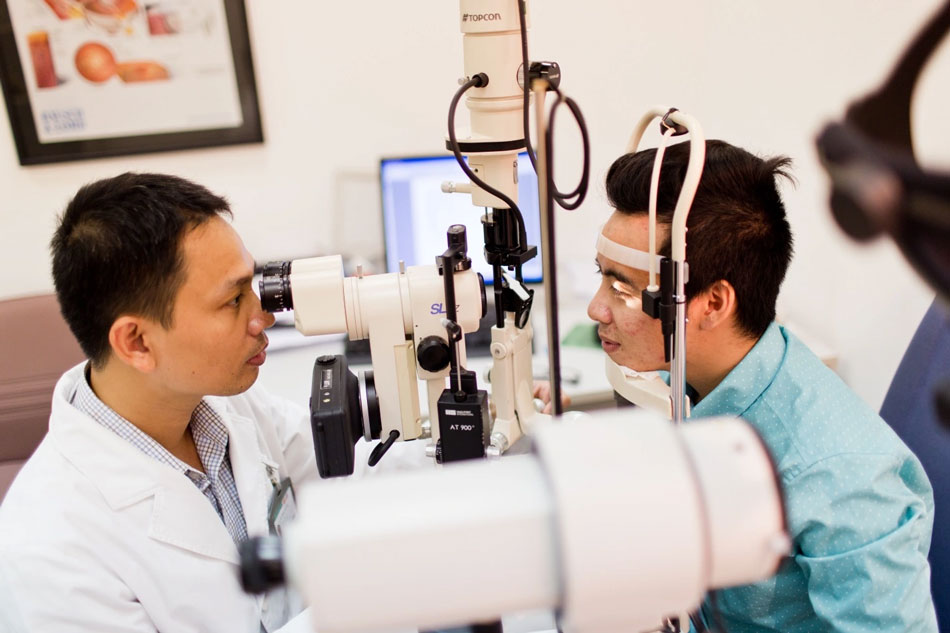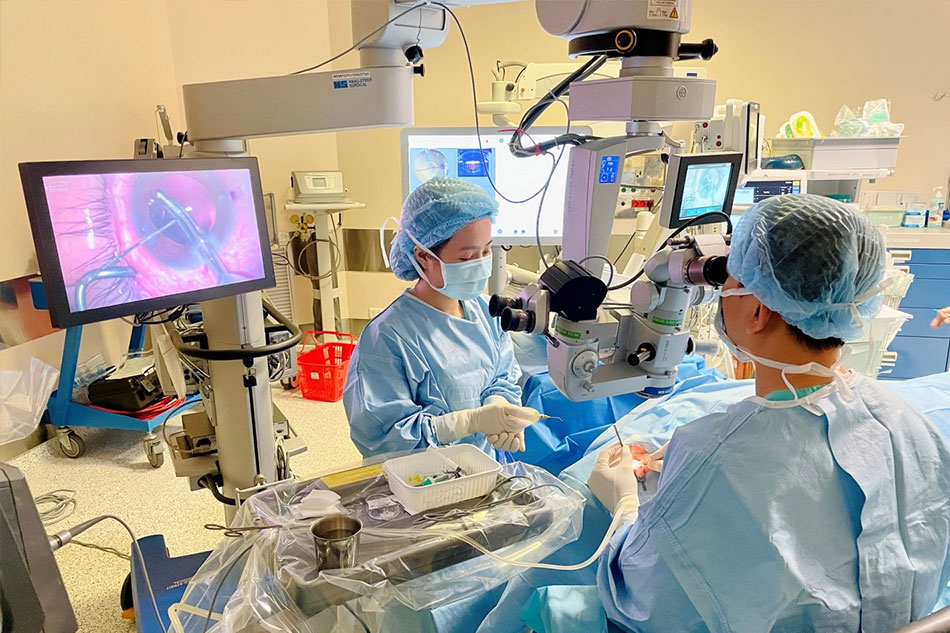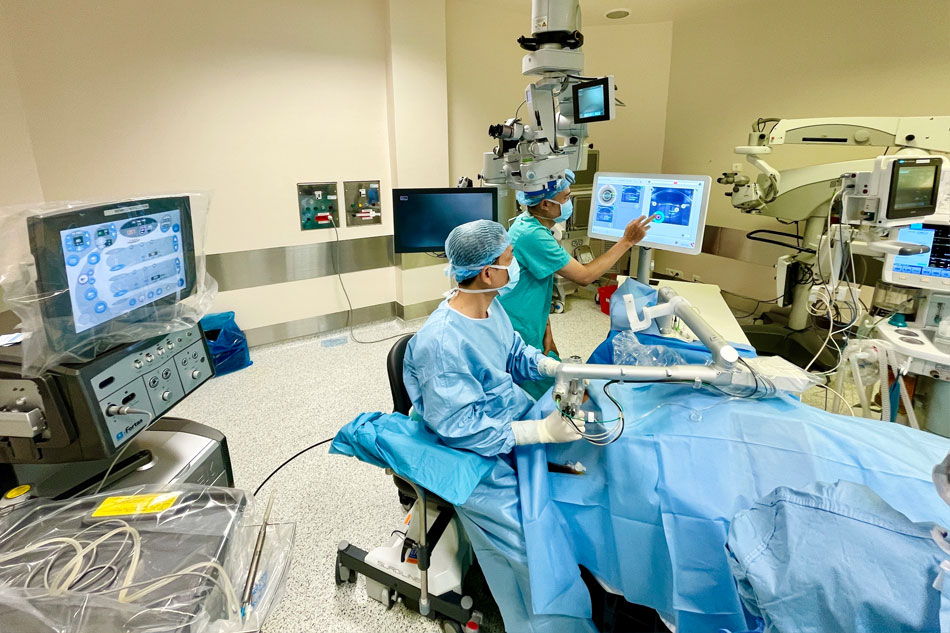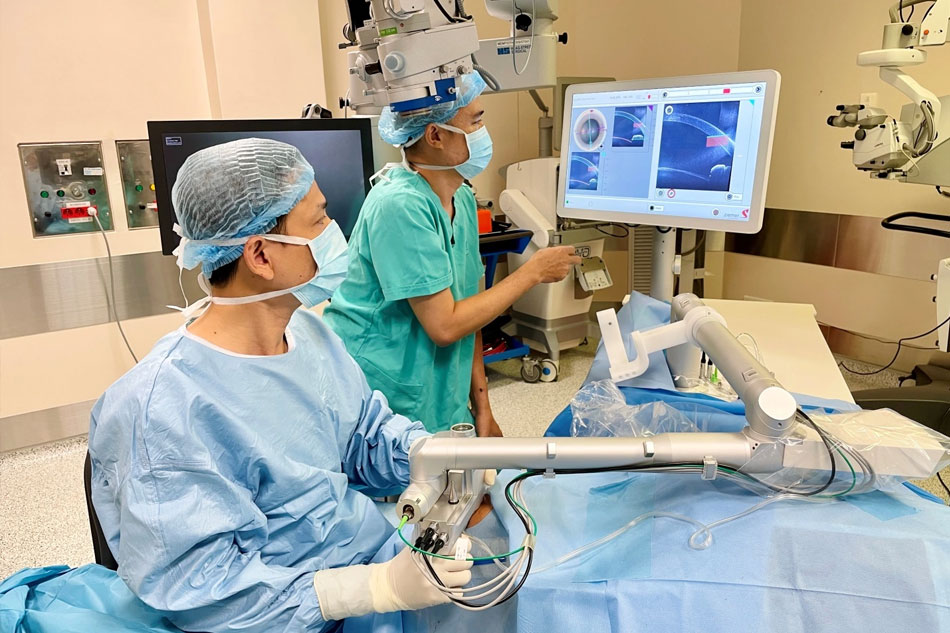Table of contents
Due to its ability to enhance surgical accuracy, limit complications and provide flexibility in combining treatments for refractive errors, Femtosecond Cataract Surgery is fast becoming the top choice for cataract treatment.
Laser Cataract Treatment
Cataracts are a common disease in the elderly. This is vision disorder is caused by a change in the protein structure of the lens, influenced by harmful substances generated from within the body or the external environment.

Cataract surgery with femtosecond laser also helps to correct refractive diseases.
Dr Hoang Chi Tam, Ophthalmology and Refractive Surgery Department, FV Hospital, says that cataracts are the leading cause of blindness, accounting for 65 per cent of blindness and visual impairment cases.
There are many causes of cataracts, including those related to genetics, injury, inflammation, conjunctivitis, and incorrect use of eye drops. However, up to 99 per cent of cataracts are attributed to aging, as they are mainly found in people aged over 60 years.
Low pulse energy in femtosecond laser cataract surgery is highly efficient
In cases of mild cataracts, patients are usually indicated to wear glasses. When patients show signs of visual impairment that cannot be improved by wearing glasses, surgery is the only method of treatment available at present.
In recent years, FV is one of the international hospitals pioneering the application of low pulse energy femtosecond laser in cataract surgery. This method includes manual operational techniques performed by the surgeon: an incision is made, the anterior capsule torn and vitreous cortex split. This method is performed with a low pulse energy femtosecond laser, which offers precise results and safer, faster postoperative recovery.
Furthermore, the nucleus of the cataract is broken into particles by the laser, which means the use of pulsing ultrasound can be reduced by up to 50 per cent. Femtosecond laser can also correct the patient’s astigmatism during cataract surgery without the need to undergo another refractive surgery.
“A femtosecond laser cataract surgery can be a cataract surgery and refractive surgery at the same time. By using laser treatment, after the surgery, the patient’s presbyopia, astigmatism, and even myopia can be fully resolved,” said Dr Tam.
A female patient, aged 60 years old, recently received femtosecond laser cataract surgery at FV Hospital around three months ago. Through examination, the doctors of Ophthalmology and Refractive Surgery determined that the patient had cataracts, myopia of up to 24 degrees, and astigmatism of 2.5 degrees.

Cataract treatment with femtosecond low-pulse energy laser at FV Hospital.
In such cases, doctors often recommend replacing the cloudy lens with an artificial lens (intraocular lens) with refractive correction. However, in this patient’s case, her degree of myopia was too high and combined with astigmatism and no suitable glasses were available on the market.
Doctors tried to order customised glasses from the manufacturer but were advised that the patient would need to wait for two to six months before they could be delivered. As the patient was elderly and already had very poor eyesight with a visual field of only three metres, her risk of falling and injury while she waited was extremely high.
Dr Tam indicated a femtosecond low pulse energy laser surgery for the patient. During the surgery, the doctor used a laser to create two flaps in the cornea to correct the patient’s astigmatism.
After surgery, the patient’s vision had reached 9/10 for both eyes, and her astigmatism was only reduced to 0.5 degrees. She was very happy because she could undertake her daily routine without assistance and even help her children. Recently, she brought a friend who also has cataracts to visit FV for treatment with a low pulse energy femtosecond laser.
Ensuring a safe, effective cataract surgery
Femtosecond laser cataract treatment has been widely applied in countries with advanced medicine, including Singapore, Malaysia, the U.S. and Europe. In Vietnam, he said, more hospitals have been equipped with modern machines and doctors from FV Hospital have been invited to provide practical training to their teams. The doctor believes that in the future, this technique will become more and more commonly applied, bringing more benefits to patients.

FV Hospital is a pioneering international hospital applying femtosecond low pulse energy laser to treat cataracts.
“The development of science and technology offers the opportunity to treat complicated diseases more effectively while making the treatment process quicker and shortening recovery times. Previously, no one thought that laser surgery could be used for cataracts, but now it is a reality,” says Dr Tam.
Dr Tam cautions that while all invasive procedures carry the risk of infection, infection risk posed by cataract surgery is low, but patients should be careful to choose a medical facility that strictly adheres to infection prevention standards and uses disposable equipment during surgery.

Cataract surgery with femtosecond low pulse energy laser at FV Hospital is performed in an operating environment that meets JCI international standards.
At FV, specialised operating room methodologies ensure infection control safety following Joint Commission International (JCI) medical standards one of the world’s highest standards for medical quality. Surgical teams comprise doctors with many years of experience, trained and guided directly by foreign experts from Switzerland, enhancing the effectiveness and safety of this treatment.
Please call (028) 54 11 33 33, extension 2000, for a cataract surgery consultation at FV Hospital.



